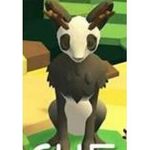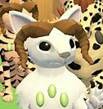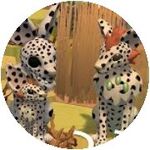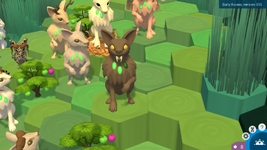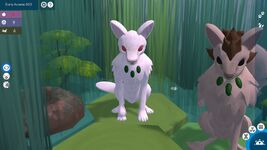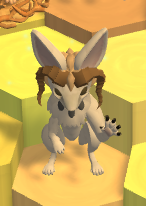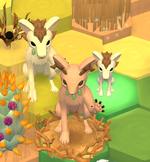Nichelings
In Niche, you control a pack of nichelings. In early versions of the game these were simply called creatures. Nichelings have a Canine / Feline (Dog / Cat) appearance, sometimes referred to as a "foxcat", with varying colors and features depending on their genes.
Actions
At the beginning of each day, all the little gems on the creatures become "lit", indicating they have full actions. Anything a creature does darkens out one gem (moving, attacking, gathering etc.).
Food
At the end of each day, 1 food will be taken for each creature in the pack, including children born that night and creatures dying that night.
Menu
When selecting a creature, a menu will pop up in the bottom left corner showing the creature's name, age, damage bar, how many actions they have left, gender, and 2 circular icons. The icon showing a DNA helix, when clicked, shows the creature's gene bar and the paw icon shows their abilities.

A creature's lifespan bar. The red is the damage they have taken, and the white is their age.
Age
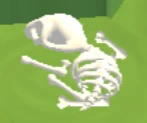
Creatures leave a skeleton behind when they die
Creatures progress through four life stages: infant, child, teen, and adult. Although there is no elder stage, adults will die of old age. The lifespan of a creature is determined by how full their life bar is. The white is the creature's age and the red is the damage they have taken. Each creature's lifespan can be reduced by injury, poison, and disease. Fortunately, it is possible to heal damage by consuming certain plants. Hovering the mouse over the lifespan bar shows the life stage, the amount of days until death, age, and the amount of days taken away by damage.
| Age | Action Points | Duration |
|---|---|---|
| Baby | 0 | 1 day |
| Child | 1 | 2 days |
| Teen | 2 | 3 days |
| Adult | 3 | 19 days |
Baby
Baby creatures do not possess abilities given by their genes. They will always have 1 speed and 1 swimming when first born. The exceptions to this are eye and ear genes. If a baby is attacked, it will instantly be killed. They are preyed on by bluebirds, and if you do not set any Alpha/Omega rankings, the youngest babies will suffer from hunger by default if you do not have enough food.
Color Code
The gems on the creatures can have any color combination of Green, Red, Blue, Pink, and Yellow. To do this, click on the three gems found on the creatures info.
Color coding can be used to organize creatures into groups.
Blue Birds
Bluebirds will eat young Nichelings with one gem or lower. The exception is if a Nicheling with 2 or more Gems is adjacent to the young one. Bluebirds cannot be reached, or attacked, by Nichelings.
Toxic Body babies are yet to be known to poison birds when eaten.
Ranks
Creatures can be assigned a rank of either Alpha, Beta, or Omega. These ranks determine when the creatures eat (Alpha has the highest priority, Omega has lowest). If there wasn't enough food, the lower priority creatures wouldn't eat.
If there were, for example, 5 creatures and 3 food, only 3 creatures would eat. If there were 2 Omegas, they would starve and the other creatures wouldn't.
Alpha creatures can also "Banish" Omega creatures. Say you have a creature with a gene that you don't want, you can use your alpha creature to banish the useless ones if you assign them to omega. The banished creature will roam around the world, free of your control.
Family Tree
All living creatures and their known parents are put on a family tree. Each icon is color coded: purple for female, yellow for male and black for a deceased parent. This tree levels creatures based on generations: every time a creature is born it is placed one generation below the lowest generation parent and is connected to its mother and father with pink and blue lines respectively (when not highlighted the lines are greyed out). Clicking on the icon of a creature in the tree will show a picture of them and their stats.
Gene and Attribute selecting
In the family tree menu at the bottom, there are 2 circles, one for attributes and another for genes. When selecting one of these circles a menu will appear displaying all discovered genes or attributes. Once a gene or attribute is selected, the family tree will be filtered - any creatures with the selected gene or attribute will be light blue and creatures carrying the selected gene in their rececive dark blue instead of white. This feature is especially good for immunities.
Adam and Eve

Adam and Eve at the beginning of a new game (Version 0.1.14)
At the begging of story mode players will start with Adam, who has fixed genetics. The next creature they will meet will be called eve. Eve has completely random genetics. If players start on sandbox mode their starting creatures will have completely random names and genes.
Wandering Nichelings
You may find other nichelings wandering around the island, stealing your food, getting in your way, and maybe killing predators and bunnies. They also can be bred without being invited, and cannot harm your creatures. You can invite these nichelings into your tribe for 5 food, allowing you to control them as your own and breed them. Wandering nichelings have normally generated names and will appear yellow in the scent and hearing maps. Nichelings in your tribe will become wandering nichelings if you banish them.
Rogue Males

A Horny Male that has impregnated two of the player's female creatures.
Rogue Males (previously Horny Males in version 0.2.9 and before) are NPC nichelings that roam around the medium and hard islands and spawn in grass or darkness. Unlike wandering nichelings, Rogue Males do no have a normally generated name, and instead will appear with only the text "Rogue Male" above their heads. The less grass or darkness there is, the lower chance of a Rouge Male (or any other unhelpful entity) spawning, not including Bluebirds. Rogue Males are in search of non-pregnant females in your tribe, and will mate with them any chance they get. They move anytime you do an action, and do not abide by the "three-move rule" of gems. You cannot invite them into your tribe, and who would want to, judging on their bad genes? Some of their genes are randomized, but they all have the following genes in common:
| Gene | Dominant | Recessive |
|---|---|---|
| Head | Spit Snout | Spit Snout |
| Eye | (Random) | (Random) |
| Eye Color | (Random) | (Random) |
| Paws | No Paw/Random | No Paw |
| Pattern | No Pattern | (Random) |
| Tail | Fluffy Tail | Swimming Tail or / Random |
| Legs | Hind Leg / Random | (Random) |
| Blood Clotting | Hemophilia | No Gene |
Trivia
- The creatures resemble canines and felines known as "foxcats"
- While intentional or not, these creatures somewhat reflect domestic cats and dogs, having many different characteristics, but are still able to breed together
- It is impossible to look at the backside of creature unless they are Rouge Males or wandering Creatures, however, using the family tree menu, the forms of the creatures can be rotated
- Creature models have changed dramatically from early stages of the game, featuring different shaped heads and ears
- On rare occasions, when a bluebird is about to attack a baby creature, if the baby grows up the next day, the bluebird will swoop down to kill it, leaving the juvenile creature with full damage and only one bit of lifespan left
- No matter how old an adult creature is, it can still mate
- Trying to go for a ferocious creature with ram horns or antlers and with claws on both paws while big bodied will make berry collecting impossible, thus forcing the player to search for prey or go hungry.
- Although the player can change their creatures' names from version 2.0.0 onward, the names given to the creatures by the game when they are born seem to be a mixture of the same prefixes and suffixes (with the exception of Adam and Eve).
- For males, common name-parts are: duk, ta, van, kir, ro, nu, ku, example Dukvankir
- For females, common name-parts are: ana, me, re, si, is, la, ra, example Anarera
- Non gender-specific: ko, ta
- Unknown: mu

